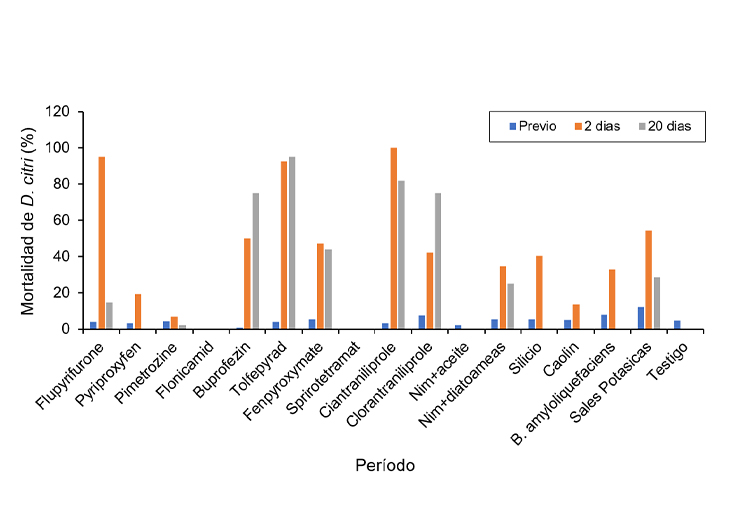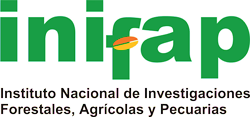Alternative insecticides for controlling Diaphorina citri Kuwayama (Hemiptera: Lividae) in lemon
DOI:
https://doi.org/10.29312/remexca.v16i6.3417Keywords:
Asian psyllids, control, natural enemiesAbstract
In Mexico, the management of Diaphorina citri in Mexican lime is mainly based on scheduled applications of synthetic pesticides, without prior sampling, or rotation of the different toxicological groups, which leads to an excessive growth of the populations of this insect due to the development of resistance because of the excessive application of these products. This study aimed to evaluate the efficacy of organosynthetic insecticides for the control of D. citri in Mexican lime and the effect of these new molecules on its main natural enemies. Sixteen new molecules were evaluated with ten replications and a completely randomized experimental design, and the variables studied were number of psyllids and natural enemies. Sampling was carried out on 2, 8, 15, 20 and 29 days after application. The following was performed using the SAS statistical program: normality and homoscedasticity test on the data of variances, Anova, and Duncan’s test (p< 0.05). Compared to the previous sampling, Tolfenpyrad® had a mortality rate of 97.5, 92.6, 95.1 and 100% at 8, 15, 20 and 29 days after application, respectively. In contrast, Cyantraniliprole® showed 93.9, 69.7, 81.81 and 100% at 8, 15, 20 and 29 days after application. However, some other products, such as Chlorantraniliprole® and Neem plus oil can be an alternative at a low pest density.
Downloads
References
Ables, J. R. and Ridgway, R. L. 1981. Augmentation of entomophagous arthropods to control insect pests and mites. In: biological control in crop production. Papavizas, G. Ed. Allanheld, Osmun Pub. London. 273-305 pp.
Bové, J. M. 2006. Invited review. Huanglongbing: a destructive, newly emerging, century-old disease of citrus. Journal of Plant Pathology. 88(1):7-37.
Cortés-Mondaca, M. E.; López-Arroyo, J. I.; Hernández-Fuentes, L. M.; Fu-Castillo A. y Loera-Gallardo, J. 2010a. Control químico de Diaphorina citri Kuwayama en cítricos dulces en México: selección de Insecticidas y épocas de aplicación. Instituto Nacional de Investigaciones Forestales, Agrícolas y Pecuarias (INIFAP). Folleto técnico núm. 35. 22 p. http://www.siafeson.com/sitios/simdia/docs/fichas-tecnicas/control-quimico-diapho.pdf.
Cortés-Mondaca, E.; Lugo-Angulo, N. E.; Pérez-Márquez, J. y Apodaca-Sánchez, M. A. 2010b. Primer reporte de enemigos naturales y parasitisme sobre Diaphorina citri Kuwayama en Sinaloa, México. Southwestern Entomologist. 35(1):113-116. https://doi.org/10.3958/059.035.0113.
Kondo, T. F.; González, F. G. y Guzmán-Sarmiento, Y. C. 2017. Enemigos naturales de Diaphorina citri. In: Kondo, T. Protocolo de cría y liberación de Tamarixia radiata Waterston (Hymenoptera: Eulophidae). 1a Ed. Corpoica Editorial. 23-32 pp.
López-Arroyo, J. I.; Loera, J.; Jasso, J.; Reyes, M. A.; Cabrera, H.; Cortez, E.; Miranda, M. A.; Fú, A.; Rodríguez, R. y Acosta, E. 2008. Avances de investigación para el manejo del psilido asiático de los cítricos en México. In: Reunión Nacional de la Fitosanidad, SENASICA. Acapulco Guerrero.
López, D. E. y Villanueva, J. J. A. 2019. Podrá Cereaochrysa valida reducir la población de Diaphorina citri. In: Memoria XLII Congreso Nacional de Control Biológico, Veracruz. 33 p.
Lozano-Contreras, M. G. y Jasso-Argumedo, J. 2012. Identificación de enemigos naturales de Diaphorina Citri Kuwayama (Hemiptera: Psyllidae) en el estado de Yucatán, México. Fitosanidad. 16(1):5-11.
Miranda-Ramírez, J. M.; Perales-Segovia, C. Miranda-Salcedo, M. A. y Miranda-Medina, D. 2021. Insecticidas de bajo impacto ambiental para el control de Diaphorina citri Kuwayama, 1908 (Hemiptera: Liviidae) en limón mexicano (Citrus aurantifolia (Christm.) Swingle). Revista Chilena de Entomología. 47(4):723-732. https://www.biotaxa.org/rce/article/view/72831.
Miranda-Salcedo, M. A. 2019. Manejo agroecológico de plagas de los cítricos en el valle de Apatzingán. In: Memoria XLII Congreso Nacional de Control Biológico, Veracruz. 37-49 pp.
Miranda-Salcedo, M. A. y López-Arroyo, J. I. 2010. Fluctuación poblacional de Diaphorina citri Kuwayama (Hemiptera: Psyllidae) y efectividad de insecticidas para su control en Michoacán. Entomología Mexicana. 9(1):577-582.
Miranda-Salcedo, M. A.; Perales-Segovia, C.; Costes-Mondaca, E.; Loera-Alvarado, E. y Miranda-Ramírez, J. M. 2020a. Manejo agroecológico de Frankliniella occidentalis Pergande (Thysanoptera: Thripidae) en limón mexicano en Michoacán. Entomología Mexicana. 183-188 pp.
Miranda-Salcedo, M. A.; Perales-Segovia, C.; Cortés-Moncada, C. E. y Miranda-Ramírez J. M. 2020b. Manejo agroecológico de Diaphorina citri Kuwayama 1908 (Hemiptera: Lividae) en limón mexicano, en Michoacán. Revista Entomología Mexicana. 7(1):176-186. http://www.socmexent.org/entomologia/revista/2020/EA/Em%20EA%20176-182.pdf.
Osorio, A. F. J.; Villanueva, A. J. L.; Ortega, D. A.; Díaz, U. Z.; García, V. M.; Luna, J. O. y Zamora, S. J. 2019. Susceptibilidad de Diaphorina citri a insecticidas en los 24 estados que operaron la campaña contra HLB. In: Memorias Congreso XXXII Investigación, Agrícola, Pecuario, Forestal, Acuícola, Pesquero y Desarrollo Rural de Veracruz. 2284-2294 pp.
Ruíz-Galván, I. N.; Bautista-Martínez, H.; Sánchez-Arroyo, F. y Valenzuela-Escoboza. 2015. Control químico de Diaphorina citri (Kuwayama) (Hemiptera: Liviidae) en lima persa. Acta Zoológica Mexicana. 31(1):41-47. http://www.scielo.org.mx/scielo.php?script=sci-arttext&pid=S0065-17372015000100006.
SAS, Institute 2010. SA/STAT Software. Versión 9.3 (TSMO). Cary NC: SAS Institute INc.
SENASICA. 2019. Servicio Nacional de Inocuidad y Calidad Agroalimentaria (SENASICA). Estrategia 2017, para la detección y control del HLB y el psílido asiático de los cítricos en México. www.senasica.gob.mx/default.asp?.
SIAP, 2022. Producción anual estatal, distrital y municipal. Secretaría de Agricultura, Ganadería, Desarrollo Rural, Pesca y Alimentación. (SAGARPA). México, DF. www.siap.gob.mx.
Stansly, P. A. 2012. Biology and management of Asian citrus psyllid and HLB in Florida. In: IV Simposio Nacional y III Internacional de Bacterias Fitopatógenas. Guadalajara. Jalisco. México.
Villanueva-Jiménez, A. J. F.; Osorio-Acosta, L. D.; Ortega-Arenas, U.; Díaz-Zorrilla, U.; García, V. M.; Luna-Olivares, S. y Zamora-Juárez, S. 2019. Susceptibilidad de Diaphorina citri a insecticidas en los 24 estados que operaron la campaña contra HLB en 2018. In: Memorias Congreso XXXII Investigación, Agrícola, Pecuario, Forestal, Acuícola, Pesquero y Desarrollo Rural de Veracruz. 2284-2294 pp. http://rctveracruz.org/descargarlibro/libros/PyE07.pdf.

Published
How to Cite
Issue
Section
License
Copyright (c) 2025 Revista Mexicana de Ciencias Agrícolas

This work is licensed under a Creative Commons Attribution-NonCommercial 4.0 International License.
The authors who publish in Revista Mexicana de Ciencias Agrícolas accept the following conditions:
In accordance with copyright laws, Revista Mexicana de Ciencias Agrícolas recognizes and respects the authors’ moral right and ownership of property rights which will be transferred to the journal for dissemination in open access. Invariably, all the authors have to sign a letter of transfer of property rights and of originality of the article to Instituto Nacional de Investigaciones Forestales, Agrícolas y Pecuarias (INIFAP) [National Institute of Forestry, Agricultural and Livestock Research]. The author(s) must pay a fee for the reception of articles before proceeding to editorial review.
All the texts published by Revista Mexicana de Ciencias Agrícolas —with no exception— are distributed under a Creative Commons License Attribution-NonCommercial 4.0 International (CC BY-NC 4.0), which allows third parties to use the publication as long as the work’s authorship and its first publication in this journal are mentioned.
The author(s) can enter into independent and additional contractual agreements for the nonexclusive distribution of the version of the article published in Revista Mexicana de Ciencias Agrícolas (for example include it into an institutional repository or publish it in a book) as long as it is clearly and explicitly indicated that the work was published for the first time in Revista Mexicana de Ciencias Agrícolas.
For all the above, the authors shall send the Letter-transfer of Property Rights for the first publication duly filled in and signed by the author(s). This form must be sent as a PDF file to: revista_atm@yahoo.com.mx; cienciasagricola@inifap.gob.mx; remexca2017@gmail.
This work is licensed under a Creative Commons Attribution-Noncommercial 4.0 International license.


